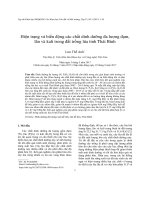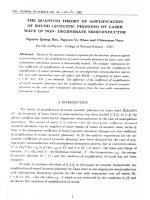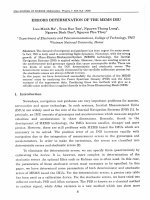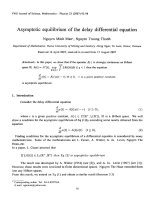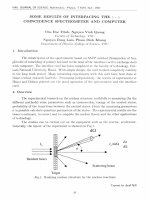DSpace at VNU: The contribution of the exchange biased field direction in multilayer thin films to planar Hall resistance
Bạn đang xem bản rút gọn của tài liệu. Xem và tải ngay bản đầy đủ của tài liệu tại đây (274.2 KB, 4 trang )
Original
Paper
phys. stat. sol. (b) 244, No. 12, 4431 – 4434 (2007) / DOI 10.1002/pssb.200777309
The contribution of the exchange biased field direction
in multilayer thin films to planar Hall resistance
Tran Quang Hung1, Pham Hong Quang2, Nguyen Trung Thanh1, Oh Sunjong1, Bharat Bajaj1,
and Kim CheolGi*,1
1
Department of Materials Science and Engineering, Chungnam National University, 220 Gung-Dong,
Yu-Seong Gu, Daejeon 305-764, Korea
2
Cryogenic Laboratory, Hanoi University of Science, 334 Nguyen Trai, Thanh Xuan, Hanoi, Vietnam
Received 7 May 2007, revised 19 September 2007, accepted 11 October 22007
Published online 12 December 2007
PACS 75.47.–m, 75.70.Cn
Recently, planar Hall effect (PHE) has been widely pursued due to its application potential for biosensors.
Planar Hall sensor is based on the anisotropy magnetoresistance and exhibits many advantages, such as
large signal-to-noise ratio at low frequencies and high sensitivity at low applied field. The planar Hall resistance (PHR) curve in multilayer thin films with spinvalve structure has pre-eminent sensitivity when
compared to single layer and bilayer thin films. In this work, we report a model for PHR calculation that
includes the behaviour of single domain basic structure in the external magnetic field. Our results show a
qualitative dependence between PHR curves and the angle (β) between the exchange biased field direction
and the easy axis of the free layer. As the β increases the sensitivity of the PHR curves also increases.
Further, it is shown that our calculation helps to determine the exchange biased field direction.
© 2007 WILEY-VCH Verlag GmbH & Co. KGaA, Weinheim
1
Introduction
The spinvalve multilayer has received much attention in recent years due to its vast potential for readheads in hard disk and magnetic tape applications [1–3]. Other applications have been envisaged, including biosensors, directional sensors and magnetic random access memories [4]. In these applications, the
key property of the spinvalve is the relatively large change in resistance that can be obtained under low
applied fields at room temperature.
In earlier magnetic read-head systems, magnetic stray fields were used to be detected using simple
permalloy-based (single layer) sensors by exploiting the anisotropic magnetoresistive (AMR) effect.
Though these structures provide better signal-to-noise ratio, they provide only ≈ 2% change in resistance;
thus, they are unsuitable to provide satisfactory sensitivity to detect the rapidly varying weak magnetic
stray fields of the present recording media. Subsequently, spin valve structures based on giant magnetoresistance (GMR) have been reported to be providing large resistance changes by about 10–20%. However, the signal-to-noise ratio of GMR spin valves is relatively small leaving scope for erroneous detection of the stray fields.
Recently, on the other hand, the planar Hall effect (PHE) in spin valves has been emerged as a better
sensitive technique to detect small deviations in the magnetization from the current direction with much
less background signal; thus useful for probing magnetization reversal and domain structure in small size
magnetic systems [5]. Nguyen Dau et al demonstrated the advantage of PHE measurements in reducing
the temperature drift by at least four orders of magnitude, and hence there is considerable increase in the
*
Corresponding author: e-mail:
© 2007 WILEY-VCH Verlag GmbH & Co. KGaA, Weinheim
4432
Tran Quang Hung et al.: Contribution of the exchange biased field direction in multilayer thin films
resolution of magnetoresistive sensors [6]. Further, the PHE has been additionally found to be more
effective for magnetic micro and nanobead detection [7] as the signal to noise ratios in these sensors are
also higher by several orders compared to others [8].
Thus, we develop and report here a model for planar Hall resistance (PHR) calculation while taking
into account of the effect of a canted pinning field in spinvalve multilayers.
2
Theoretical background
Ohm’s law, in general, expresses the symmetry of the Hall and Magnetoresistance effects. In this discussion the electric field inside an isotropic material is related to the current density by Ohm’s law [9]
E = ρ .J .
(1)
In general, ρ is a tensor given by
ρ^ ( H ) - ρH ( H )
ρH ( H ) ρ^ ( H )
0
0
0
0
(2)
ρ // ( H )
for H parallel to the z direction. Here ρ┴ (ρ//) is the resistivity in a direction perpendicular (parallel) to the
H field (which, in the case of a ferromagnet, is replaced by the magnetization) and ρH is the Hall resistivity. All the components of the resistivity tensor depends on the magnitude of H. Ohm’s law can be rewritten as follows:
E = h( J .h)[ ρ - ρ ] + ρ J + ρ h ¥ J
//
^
^
H
(3)
where h is a unit vector in the direction of the applied field for a ferromagnet, the magnetization. In Eq.
(3), it is shown that the spontaneous magnetoresistivity is a function of the relative direction of M and J.
Normally, the PHE or PHR in magnetic conductors occurs when the resistivity depends on the angle
between the direction of current density J and the magnetization M, known as the anisotropic magnetoresistive (AMR) effect. When M makes an angle θ with J, the AMR effect is described by magnetization
reversal of the single domain as following;
Ex = j ρ ^ + j ( ρ // - ρ ^ ) cos 2 θ ,
E y = j ( ρ // - ρ ^ )sin θ cosθ ,
(4)
where the transverse induced-voltage related to Ey in Eq. (3) is called by PHR voltage, and it is revealed
when anisotropy of resistivitive exists.
In order to understand the PHR curves theoretically in magnetic layers, a model which is based on
magnetic density energy was used. Commonly it is assumed that in spin valve structure the exchange
coupling with antiferromagnetic (AFM) layer results in a single domain behavior in the ferromagnetic
(FM) layer.
In spin valve structure, the reversal of FM films could be treated by the Stoner-Wohlfarth model [9,
10]. The magnetic energy per unit of FM layers can be written as follows:
E = - H p M s t p cos( β - θ p ) + K up t p sin 2 θ p
- M sp t p H cos(α - θ p ) + K uf t f sin 2 θ f
(5)
- M sf t f H cos(α - θ f ) - J cos(θ f - θ p ).
Here, the tf and tp; θf and θp; Kuf and Kup; Msf and Msp, are thickness; the angles between magnetization
and easy axis direction; the effective anisotropy constants; and the saturation magnetization of the free
and pinned layers, respectively. Hp is the pinned field (exchange biased field that is induced from interaction between AFM and FM layers [11]), J is the interlayer coupling, α is the measurement angle between
© 2007 WILEY-VCH Verlag GmbH & Co. KGaA, Weinheim
www.pss-b.com
Original
Paper
phys. stat. sol. (b) 244, No. 12 (2007)
4433
external magnetic field and easy axis, and the β is the angle between the exchange biased field direction
and the easy axis of the free layer.
During calculations, the exchange biased field between the pinned FM layer and AFM layer in the
spin valve structure is assumed strong enough to assign a zero angle for θp and a maximum variation (0180°) for θf on external magnetic field reversals. In the Stoner-Wohlfarth model, energy term can be
rewritten as follows [12]:
E = K u t sin 2 θ - M s tH cos(α - θ ) - J cos( β - θ ),
(6)
nπ ( -1) n
+
arcsin(V ( H ) / Vmax ) ,
2
2
n = 0, ± 1,
(7)
where the Vmax is the maximum PHR voltage and
the value of n should be chosen to keep the continuous existence of θ(H).
From Eqs. (6) and (4), the PHR profile can be
calculated theoretically as shown in Fig. 1 under
the condition that the energy E is minimum.
3
Results and discussion
In our calculation, when β in Eq. (7) is varied from 0
up to 90 degrees, the theoretical calculation of PHR
profiles is shown in Fig. 2.
The PHE curves based on this model were obtained
by numerical calculation. Once the angles (α, β) and
applied field H are chosen, the energy E can be computed for the angles (α, β) from Eq. (7), and the angles
(α0, β0) for which energy E is a minimum can be
found. Then the PHE voltages can be obtained from
Eq. (6).
Figure 2 shows that when the β value is positive
(the exchange biased field rotates in plane in an anticlockwise direction), the PHR curves shift towards
the negative direction of the applied magnetic field as
β increases and vice versa.
From Fig. 2 we can also calculate numerically the
sensitivity of PHR curves corresponding to different β
values: 0o, 15o, 30o, 60o and 90o. The change of sensitivity is given in Table 1 below.
www.pss-b.com
H (Oe)
Fig. 1 The calculated profile of PHR based on Ohm’s
law and Stoner-Wohlfarth model.
PHR (Ω)
θ (H ) =
PHR (mΩ)
where J is interlayer coupling between pinned and free layers.
In this calculation, it is also assumed that the magnetization distribution of ferromagnetic layer is in a
single domain state as a function of external applied magnetic field. In this case, the angle between magnetization and induced unidirectional anisotropy of
ferromagnetic layer can be obtained from measured PHR voltage as follows:
β = 0o
β = 15o
β = 30o
β = 60o
β = 90o
H (Oe)
Fig. 2 PHR curves depend on the β values.
© 2007 WILEY-VCH Verlag GmbH & Co. KGaA, Weinheim
4434
Tran Quang Hung et al.: Contribution of the exchange biased field direction in multilayer thin films
Table 1 The sensitivity of PHR with several values of β
beta (o)
sensitivity (µΩ/Oe)
0
1.6
15
1.8
30
2.1
60
3.4
90
5.7
During our experiment, we fabricated multilayer
spinvalve thin films Ta(5)/NiFe(6)/Cu(3)/NiFe(3)/IrMn(15)/Ta(5) (nm) in 100 (Oe) applied magnetic
field. The experimental PHR curve (dot line) of 3×3
µm2 junction and fitting curve (solid line) of selected
sample is given in Fig. 3. In numerical calculation, we
use the values, Ku = 2×103 erg/cm3, Ms = 800 emu/cm3,
J = 10-3 erg/cm2, Hk = 2Ku/Ms and R0 = (ρ// - ρ┴)/t = 44
µΩ. By changing β value of the calculation we found
that the experimental curve and fitting curve are in
good concurrence at β = 19o. This means that the exchange bias field of selected sample has some deviation
from the longitudinal axis of the sample due to the
demagnetization field and interlayer coupling.
4
Conclusions
PHR (Ω)
From Table 1 the sensitivity of PHR increases when the angle between the exchange biased field direction and the easy axis of free layer β increases, the sensitivity changes quite large amount when β
changes from 0o up to 90o. This shows that the sensitivity of PHR sensor increases when the exchange
bias field direction tilts at an angle of the longitudinal axis.
• Experiment curve
Fitting curve with β = 19o
H (Oe)
Fig. 3 Experiment PHR curves and fitting curve
with β =19o of 3×3 µm2 junction of selected sample.
A model to calculate the sensitivity of PHR versus
external magnetic field dependence on the β value of
multilayer spinvalve structures has been proposed. It is shown that increasing angle (β) between the
exchange biased field direction and the easy axis of the free layer not only steady shifts the experimental
PHR curve towards the magnetic field axis but also increases the sensitivity of the PHR curve. The best
fitting of calculations with the experimental curve amply demonstrates that our work provides a good
tool to determine the direction of exchange bias field of multilayer spinvalve structures, which is immensely helpful for fabricating PHR sensors.
Acknowledgements This work was supported by KOSEF through ReCAMM, MIC under project number A11000601-0033 and project number QG-06-03.
References
[1]
[2]
[3]
[4]
[5]
[6]
[7]
[8]
[9]
[10]
[11]
[12]
M. N. Baibich et al., Phys. Rev. Lett. 61, 2472 (1988).
A. Moser et al., J. Phys. D, Appl. Phys. 35, R157 (2002).
K.-M. H. Lenssen, A. E. M. de Vierman, and J. J. T. M. Donkers, J. Appl. Phys. 81, 4915 (1997).
D. D. Tang, P. K. Wang, V. S. Speriosu, and S. Le, IEEE Trans. Magn. 31, 3206 (1995).
Z. Q. Lu, G. Pan, and W. Y. Lai, J. Appl. Phys. 90, 1414 (2001).
F. Nguyen Van Dau, A. Schuhl, J. R. Childress, and M. Sussiau, Sens. Actuators A 53, 256 (1996).
L. Ejsing et al., Appl. Phys. Lett. 84, 4729 (2004).
B. H. Miller and D. Dahlberg, Appl. Phys. Lett. 69, 3932 (1996).
R. C. O’Handley, Modern Magnetic Materials: Principles and Applications (John Wiley & Sons, Inc., 2000).
Z. Q. Lu and G. Pan, Appl. Phys. Lett. 80, 3156 (2002).
J. Nogués and I. K. Schuller, J. Magn. Magn. Mater. 192, 203 (1999).
N. T. Thanh et al., J. Magn. Magn. Mater. 304, e84 (2006).
© 2007 WILEY-VCH Verlag GmbH & Co. KGaA, Weinheim
www.pss-b.com


